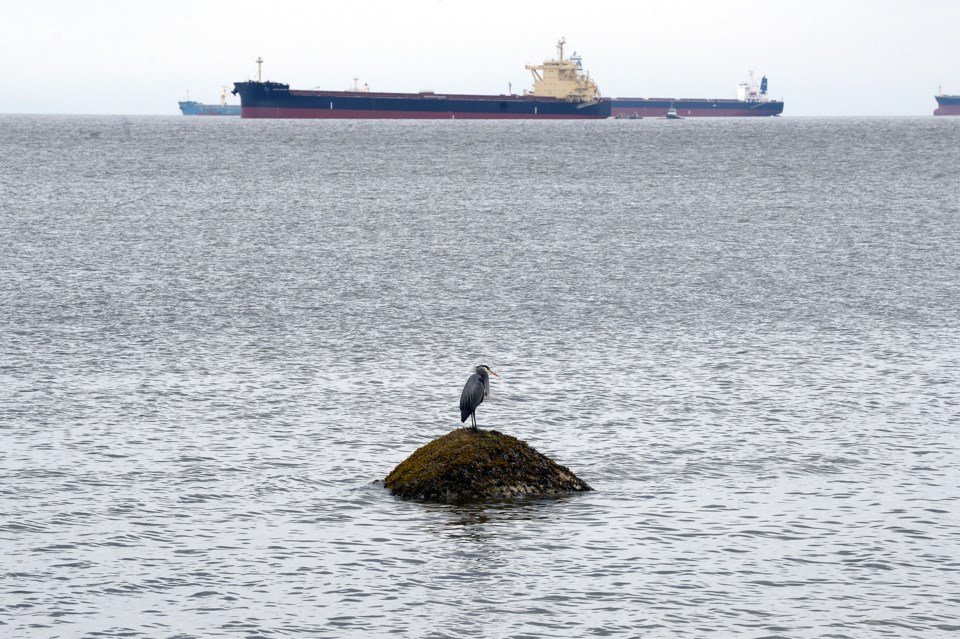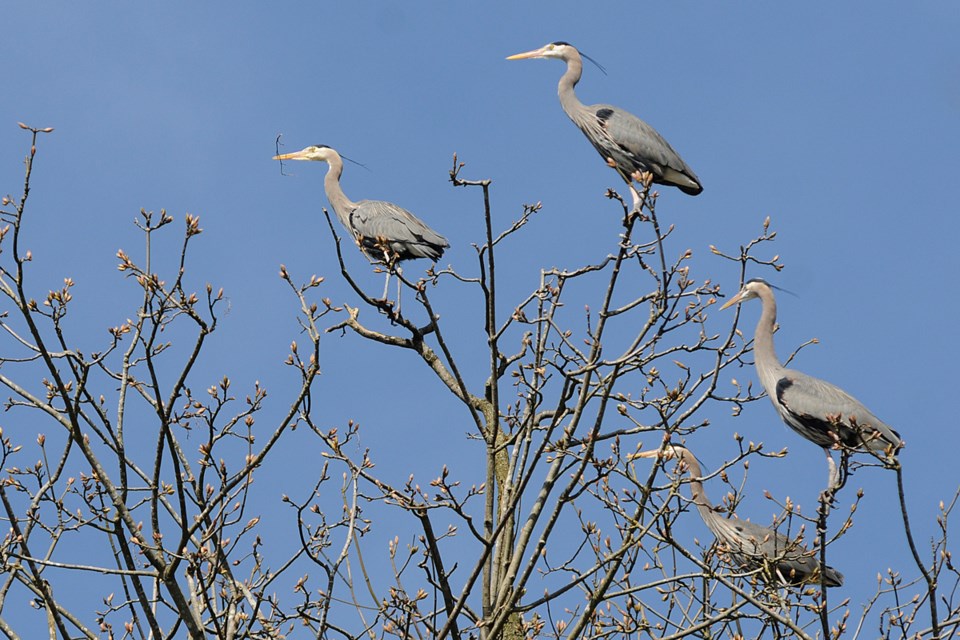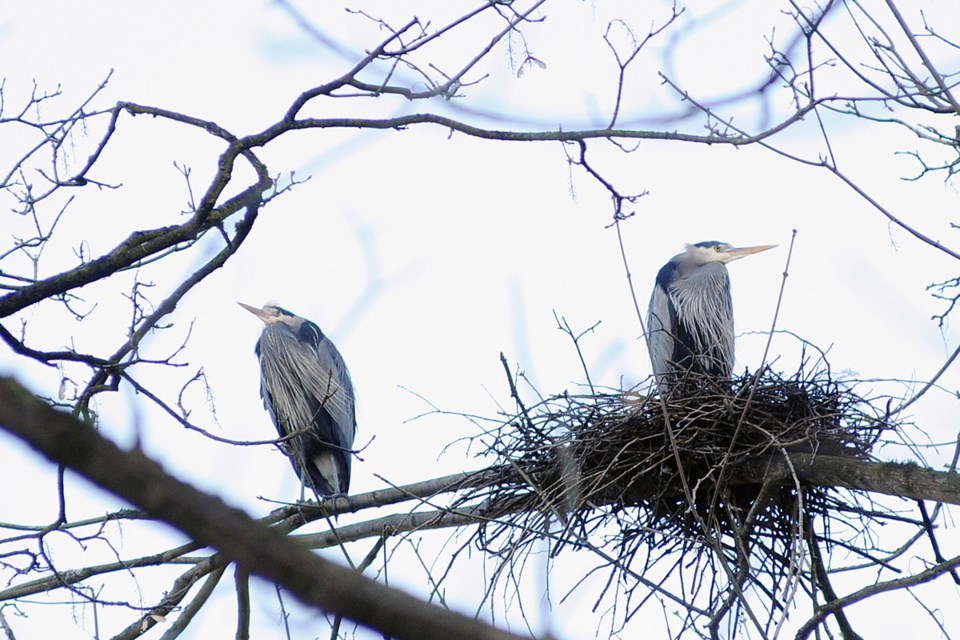The popularity of nature cams has hit peak Attenborough thanks in no small part to inspiration from spectacular footage shown on documentaries like Planet Earth. Vancouver has one of its own, a camera aimed at nests in the treetops with a backdrop of tennis courts.
In a unique setting on the edge of the West End, one of the largest urban heron colonies in North America is returning to roost for a 17th year.
The sights, sounds and smells of this heronry are full-sensory.
“You can see these magnificent birds flying in and out, you can hear the wings flapping, their squawking and their bills clapping,” said Greg Hart, the urban wildlife programs coordinator at the Stanley Park Ecology Society. “You can definitely smell them as the season goes on. There is no mistaking they are there.”
Director’s cut
For a round-the-clock window on wildlife in this city, the Vancouver park board has switched on its “heron cam” now that Pacific great blue herons are returning to claim their nests near the Beach Drive entrance to Stanley Park. Their urban colony, located near the tennis courts near the park board office, is one of the largest in North America.
The camera affords different views of the birds, including tight-angle shots on 11 trees with close-ups on numerous nests.
Since a pair of herons will return to the same nest all season long, viewers can make note of the specific camera angle (for example, “tree J” with nests one through three) to observe the progress of the birds and babies until they fly away until next year. I’m following “Tree B Nest 1.”
Viewers can also take a screen-shot of what they see.
Adopt-a-nest
The Stanley Park Ecology Society started fundraising through symbolic adoptions in 2015. For $52, sponsors can help protect the nesting site by funding the society to safeguard the colony and also monitor the heron population for ongoing research.
Groups of co-workers and elementary school classes have adopted nests in the past.
“We also work with other staff and the park board to do monitoring from ground and rooftop so we can get a population count and figure out just how productive the nests are,” said Hart.
For more information on this program, visit the society's adoption page for details and registration.

Winged urban colonizers
The camera switched on earlier this month at the Stanley Park colony once the first herons settled in March 11. Last year, nesting began three weeks earlier on Feb. 19.
Over the course of the previous season, there were 83 active nests and an estimated 183 fledglings took flight. If they survived, chicks left the colony in July last year for marshland feeding grounds near places like Iona Beach and Boundary Bay.
The heronry has roughly 80 viable nests, and breeding pairs will work together to maintain an existing nest or put in the effort to build one from scratch using twigs to create a bowl as large as one metre across to protect a soft centre lined with such things as moss, lichen and leaves where the adults will incubate eggs and feed hatchlings.
When they return to the colony, males will scope out and claim a nest that appeals to them. They use their new address to appeal to potential mates, said Hart. In a property market as lucrative as Vancouver, it is really too easy to anthropomorphise herons.
“Seasonally monogamous,” herons will partner for a summer to nest, breed and then feed chicks.
They can also be aggressive at this time of year but not towards people, said Hart.
“The males, they have trying to claim a nest and they are defending it to appeal to potential mates. You will see them engaging in this really cool behaviour --- the male will lunge at the female and she will grab his beak and they call this a ‘bill duel,’ which also serves to strengthen their beaks and calm the male.”
Viewers can see all this now on the heron cam.
The first chicks will hatch in April. “We are just at the very beginning,” said Hart. “After courtship, copulation happens and then 10 days later, they will lay eggs and then it will be 28 days until those eggs start to hatch.”

Unique species at risk
The slightly smaller, darker-plumed Pacific great blue heron is unique because it does not migrate as most great blues do. Their natural habitat is concentrated in the Lower Mainland, particularly the Fraser River delta, and is under significant pressure from urban development and human disturbance, resulting in the loss of feeding and breeding grounds.
Full-grown males have a wingspan of two metres and can live up to 18 years in the wild although 10 years is more typical for this species at risk.
The global population is between 9,500 and 11,000 nesting adults but has dwindle over the past three decades and in Canada is thought to be between 4,000 to 5,000 with approximately 3,300 concentrated right here around the Salish Sea. Given a “vulnerable” status in B.C. late last decade, ongoing decline of the Pacific great blue heron may put them on the “endangered” list at the next review, according to information from the Stanley Park Ecology Society.
“The population over the past decade has gone down, which is what makes this colony important despite being in such a built-up urban environment,” said Hart.
Nesting amid high-rises
The first documented sighting of a heron in Stanley Park was a photograph taken in 1921, when swaths of downtown were still swampy mud pits and most of Kitsilano an un-felled forest.
Testing new things this weekend? Catch the heron chicks test their new wings at https://t.co/V789zllZGA #HeronTalk pic.twitter.com/rTKuiFJMEs
— Vancouver Park Board (@ParkBoard) June 11, 2016
Today, the colony located beside the park board office near the entrance on Beach Drive has been roped off to help maintain an undisturbed habitat. The trees have been covered in wire mesh and protective padding to deter ground predators like raccoons and curious onlookers, like dogs and people, from getting too close.
Owls and bald eagles also prey on the nests, but there is a working theory the herons benefit from the high-rise towers in the West End because they offer a certain amount of protection from air attacks, said Hart.
“I don’t think we have a specific answer, but they did choose this location back in 2001 so they are clearly OK with it. There is a through that, perhaps, the downtown offers a bit of protection from eagles.”
The success rate of the Pacific heron has dropped from more than 90 per cent between 1977 to 1981 to fall below 50 per cent in 2000, the year of the most recent data available through the Stanley Park Ecology Society. Although the largest threat to the species is us and the pressure we put on the natural environment, there is no denying the birds at the Stanley Park heronry are showing an ability to adapt and live in somewhat harmony with human neighbours.
Watch the heron cam online here.
Twitter: @MHStewart



